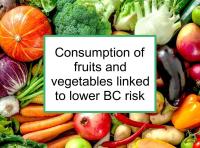Numerous studies have examined how various dietary patterns influence breast cancer risk. Diets high in fruit and vegetables and low in refined carbohydrates and saturated fat are associated with reduced risk. Levels of certain micronutrients such as beta-carotene and sulforaphane are also associated with lowered risk.
Certain vitamin and mineral deficiencies have been linked to increased breast cancer risk. However excessively high levels of some micronutrients (obtained through supplements) have the potential to increase risk.
Diet-related studies have sometimes produced inconsistent or contradictory results, in part because of differences of aspects of study design and how diet is measured. Nevertheless, the results of large, carefully designed studies can encourage women to move from unhealthy cancer-promoting diets to healthier eating patterns.
In fact, not all vegetables are equally beneficial in protecting against breast cancer. This is why there are no news stories admonishing us to eat green beans to prevent cancer whereas there are favorable reports concerning broccoli from time to time. In addition, there is evidence that some foods act synergistically with others in reducing breast cancer risk. For example, several studies have reported that the beta-carotene in foods such as tomatoes and squash is made more bioavailable when such foods are consumed together with olive oil or black pepper. Now a major new study conducted by researchers at Harvard Medical School has reported that increased consumption of fruits and vegetables, especially cruciferous and yellow/orange vegetables, is associated with significantly lower breast cancer risk, and that this effect varies according to breast cancer subtype.
Cruciferous and yellow/orange vegetables
Below is a list of common cruciferous and yellow/orange vegetables that have been found to be associated with reduced risk of breast cancer and improved surivial:
Latest research finds effect of fruits & vegetables varies
The study referenced above was designed to investigate the associations between fruit and vegetable consumption and breast cancer risk, and included analyses according to specific fruits and vegetables, menopausal status, and breast cancer subtype. The study included 182,145 women (aged 27 to 59 at enrollment) in the Nurses' Health Studies (NHS, 1980‐2012 and NHSII, 1991‐2013), which are prospective studies. Fruit and vegetable consumption was averaged across repeated, validated questionnaires. A total of 10,911 of the participants were diagnosed with invasive breast cancer during the study periods.
Higher total intake of fruits and vegetables, in particular cruciferous and yellow/orange vegetables (typically with high carotenoid content) was found to be associated with significantly lower breast cancer risk (11% lower risk for those consuming more than 5.5 servings per day compared to those consuming 2.5 or fewer servings). Higher intake of vegetables was especially associated with lower risk of estrogen receptor negative (ER-) breast cancer. Higher intake of both fruits and vegetables was most strongly associated with lower risk of HER2+ (22% lower risk compared to low consumption), followed by basal-like (usually ER-/PR-/HER2-) disease (15% lower risk), and luminal A (6% lower risk), but not with luminal B disease. Luminal A tumors are normally strongly estrogen receptor positive (ER+) and progesterone receptor positive (PR+) and not HER2-positive. Luminal B tumors weak to moderate ER+/PR+ and can be HER2- or HER2+. The authors conclude that higher intake of fruits and vegetables, in particular cruciferous and yellow/orange vegetables, may reduce breast cancer risk, especially the risk of more aggressive HER2+ or triple negative tumors.
Please see the overall diet tag for more information.
